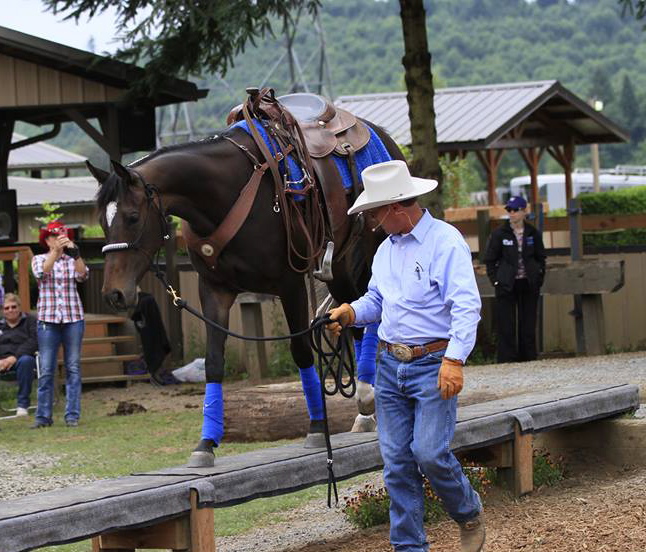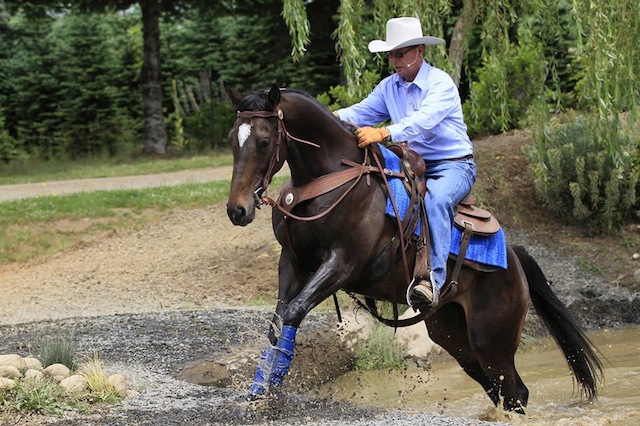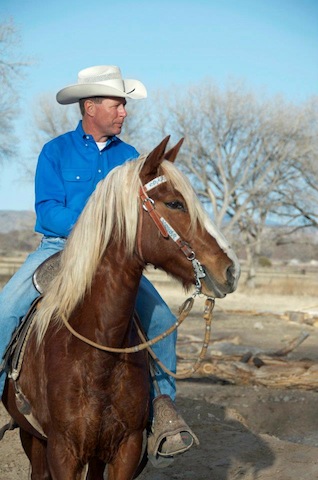
Mark Bolender becomes the ‘Alpha Mare’ to enlist Dakota Demon in training.
Put a herd of 25 horses together for the first time, and after some kicking, biting, and a few flying tufts of torn-out hair, an alpha mare will emerge.
In 97 percent of the time, after the dust settles, it is the female horse who emerges victorious as the leaders, says Mark Bolender ofBolender Horse Park in Washington.
All devotion is vested in her, as long as she leads in a focused and consistent manner. But if she veers into inconsistent and unfocused leadership, the herd will turn on her and kill her.
“Once she is chosen, an instinct will come into her to die protecting her herd,” says Bolender, one of five trainers participating in the Emerald Downs Prodigious Fund’s Trainer Challenge. “This is how they’ve survived longer than we have.”
In this week’s Clubhouse Q&A, Bolender talks about getting into the head of a horse as he trains off-track Thoroughbred Dakota Demon to willingly, and bravely face the challenges of learning a new career.
Q: Please tell me about your philosophy of training horses.

Dakota was once on her way to being the Alpha Mare, but she relinquished that easily to her trainer.
My philosophy is that I started with Natural Horsemanship principals and traditional training, and connected the dots. I have a photograph that I show people at clinics I teach; it’s an old photo that shows a horse walking across a seven-inch beam. If you look closer you’ll see the horse is blindfolded, and if you look again, you realize the trainer is not touching the horse. I’m the man who wants to know why. We’ve taught horses to set up for lead changes and to slow down, but not many people can tell you why we do what we do, and why it works.
Q: When you begin training, you speak the horse’s language. How?
When we train, we enter into the horse’s world, for the most part. We train them under our human values. But, the horse’s world is very different from ours, with different values. We are not superior. We are not inferior. The horse is just a different nation that hears different voices, and they react with different senses that we never had, or we have lost.
A horse will size you up within the first hour of meeting you. You have to remember that to a horse, you’re either inferior or superior, and he’s trying to figure that out. So to train, you have to establish yourself as the Alpha Mare.

Dakota’s instinctive reactions to new stimulus are overridden by her desire to please her trainer.
Q: The Alpha Mare?A horse will size you up within the first hour of meeting you. You have to remember that to a horse, you’re either inferior or superior, and he’s trying to figure that out. So to train, you have to establish yourself as the Alpha Mare.
If you watch 25 horses interact in a field together for the first time, you quickly have disorder. There’ll be kicking and biting, bumps and scratches. And out of that comes order—the pecking order.
Once that pecking order is established, in 97 percent of the time, it is an Alpha Mare who is chosen to lead. Once she is chosen, an instinct will come into her to die protecting the herd. It’s amazing; I’ve seen it. The second instinct is that the herd will follow that mare to their death.
As soon as she loses her consistency as their leader, they’ll turn on her and kill her. It’s instinctive: they’ll die following their leader, but if she’s not worthy, they’ll kill her.
Q: How does this translate into the working relationship between horse and human?
You have to understand that to a horse, they don’t have equals. You’re either inferior or superior to them. If you can establish yourself as their superior, as their Alpha Mare, they’ll want to please you. So the first thing a trainer has to achieve is for that horse to believe in us as being worthy of a leadership role. When that happens, most of your work is done.
Q: And how does a human project a leadership role with a horse?

Mark Bolender relaxes on the farm.
A lot of it comes down to the less you do, the more what you do means. For example, when I work with a horse, the less I move, the more I mimic their language. If I see a person being touched by a horse in the training moment, while doing groundwork, if that horse walks up and touches them, that horse is telling them they’re inferior.
If you watch an Alpha Mare in a herd, nobody touches her unless she invites them to. If she backs up, they all back up. A horse will never enter the Alpha Mare’s space without her permission.
In my clinics, one of the first exercises I have my students do is to stand between me and their horse, with the horse behind them. Then, without looking at their horse, I have them back their horse up. In order to achieve this, the person must be very focused and take the role of the Alpha Mare.If you watch an Alpha Mare in a herd, nobody touches her unless she invites them to. If she backs up, they all back up. A horse will never enter the Alpha Mare’s space without her permission.
Q: What does this mean for all the horse lovers who coddle their horses and kiss their faces? Is this wrong?
Love covers a multitude of sins! But, it’s important to remember that they’re not little babies. If you want your horse to respect you as a trainer, you need to be the leader. I’m not talking about a dictatorship, but of becoming a leader worthy of being followed.
When you train a horse, you’re not doing it because they’re dumb. You want them to step up to the plate, and the more they believe in you, the faster it goes.
Q: Dakota Demon was an Alpha mare herself. Did that make your job with her more difficult?
No. The Alpha Mares actually relinquish their status faster than other horses, we find. So they’re actually easier to train. Dakota is a very smart horse, and she’s getting better and better.
Q: How does Dakota and her quick adjustment to a new discipline fit into the issue of the unwanted horse?
Dakota was clearly a horse who was not going to make it in racing, but we can make them ready for something else. I think we can easily make good trail horses out of off-track Thoroughbreds. They’re beautifully minded horses, but you can’t cowboy them into it, you have to outthink them. — Originally published July 31, 2013.


OMG! Your comment “you can’t cowboy them, you have to out think them” is what I’ve always said!! I grew up with thoroughbreds!!